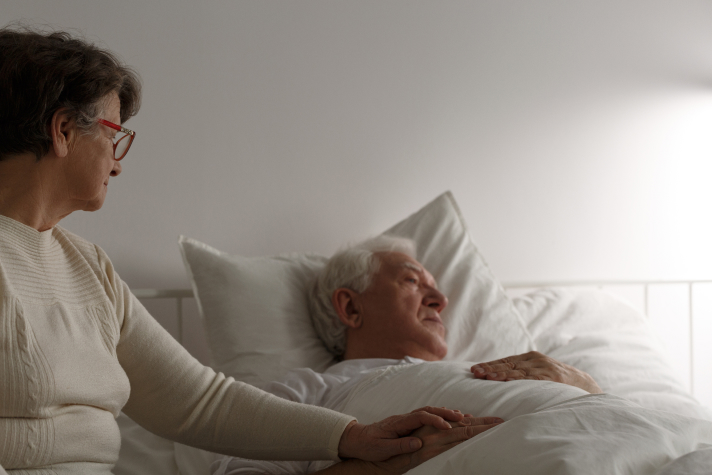As with birth, everyone’s experience with death is unique. While some may have a gradual journey, others may decline quickly. Caring for someone nearing the end of life is an incredibly profound and personal experience, marked by unique challenges and deep emotional bonds. Whilst it is a privilege, it can also take a significant toll both physically and emotionally on both the person dying and the caregiver, particularly if they are providing 24/7 care for a loved one in their home. Without the right support, the pressure of having only one chance to ensure a loved one’s final journey is comfortable, dignified, and aligned with their wishes can make end-of-life care overwhelming.
If you are caring for a loved one, understanding the stages of this journey can bring comfort and clarity when you seek it the most. This blog aims to guide you through these stages, offering insights and practical advice to help navigate this sacred time with compassion, dignity, and the necessary support to ensure the last moments are as peaceful and meaningful as possible.
The Difference Between
There is often some confusion between end-of-life care and palliative care, as the terms are frequently used interchangeably. While they are connected, they are, in fact, distinct. Before we move onto the stages of end-of-life, it is important to just clarify the differences between these two types of care:
Palliative care can begin as soon as someone is diagnosed with a life-limiting illness, such as terminal cancer, or at any stage thereafter when symptoms start to advance. Often, palliative care is provided alongside other treatments like chemotherapy. Its primary aim is to manage pain and other symptoms to allow the individual to live comfortably and fully for as long as possible, even if a cure is not achievable.
In comparison, end-of-life care is the final stage of palliative care, administered during the last few weeks, days, and hours of a person’s life. The goal of end-of-life care is not to prolong life but to ensure that the individual’s dying wishes are honored and that their transition is dignified and pain-free, providing complete peace in their last moments.

How Long Is End Of Life Care?
As we mentioned at the beginning, everyone’s journey towards death is unique, so there is no one-sized-fits all timeline of what will happen and when, when it comes to the end of someone’s life. For this reason, it is impossible to say how long each end-of-life stage will last. However, the information below provides a generalised overview of common signs and changes observed as a person progresses through various stages towards the end-of-life:

A Few Months Before Death
- Decreased appetite and weight loss.
- Fatigue and decreased energy.
- Mild pain and discomfort.
- Withdraw from people and stop doing the things they have always enjoyed.
- Normal breathing patterns.
- Cool extremities.
- Emotional adjustments to prognosis.
- Reduced peripheral circulation.
- Decreased urine output and bowel movements.
- Sensory awareness changes.
- Ability to communicate effectively.
- Medications focus on symptom management.
Top tips: this is a good stage to discuss their care going forward and to facilitate meaningful conversations with regards to if your loved ones has an advance care directive, if they’ve named someone to make important decisions about their medical care and if they know where all their relating paperwork is/what their online passwords are if online. You can also ask if they have a current will, funeral preferences, and other requests.
Do not forget about the details either. Now is the time to discuss the preferences of your loved ones with regards to all aspects of their end-of-life journey, from bucket lists, to who they want present and when.
A Few Weeks Before Death
- Further weight loss and muscle weakness.
- Increased sleepiness and difficulty staying awake.
- Increased pain and discomfort.
- Irregular breathing patterns
- Mottling and coolness of the skin.
- Heightened emotional responses and reflections.
- Further reduction in circulation.
- Urinary and bowel incontinence.
- Heightened sensitivity to touch and sound.
- Difficulty speaking or finding words.
- Increasing need for symptom management medications.

Last Hours Before Death
- Profound weakness and fatigue.
- Decreased responsiveness and ability to communicate.
- Pain may be difficult to control despite medication.
- Irregular, shallow, or noisy breathing (death rattle).
- Bluish or greyish skin tone – looks like bruising.
- Withdrawal and decreased responsiveness.
- Cold extremities due to decreased blood flow.
- Inability to swallow or process food and fluids.
- Sensory shutdown – decreased response to what is going on around them.
- Speech may become unclear or may be unable to speak.
- Focus on comfort measures – adjust medications accordingly.
Top tip: If you haven’t done so already, take the opportunity to say goodbye to your loved one when transitioning to this stage. Remember, hearing is the last sense to go, so if have something you want to say, even if your loved one seems unresponsive, they may still hear you.
At The End
- Minimal or no appetite.
- Complete loss of consciousness.
- Pain often diminishes.
- Very shallow or absent breathing.
- Cool to the touch.
- Profound peace or detachment.
- Slow, weak pulse.
- Minimal or no urine output. No bowel movements.
- Complete sensory shutdown.
- Inability to communicate verbally.
- Medications for comfort and symptom relief.
How Can Verilife Help With End-Of-Life Care At Home?
Verilife Home Care Services provides comprehensive end-of-life care at home, focusing on comfort, dignity, and support for both the individual being cared for and their families. Our services include pain management, symptom control, emotional and psychological support, and assistance with daily activities. Our trained professionals create personalised care plans tailored to meet individual needs, ensuring a peaceful and respectful environment. Verilife aims to maintain the highest quality of life possible during this challenging time, prioritising compassionate care and providing the guidance needed for families navigating the end-of-life journey.

